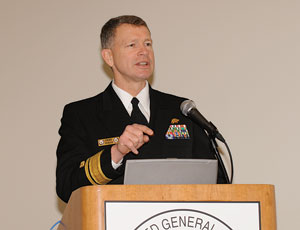Contractors are not pinning their hopes on the Obama administration’s stimulus efforts to completely pull them from an economic riptide that threatens not only profitability, but solvency. But they do see the $787-billion stimulus package’s $130 billion of construction spending as a life preserver that will allow them to at least tread water over the next year or two.

“It is absolutely necessary for our industry...but this is not an infrastructure panacea,” said Stephen Sandherr, chief executive of the Associated General Contractors of America, to hundreds of attendees at AGC’s annual convention, held March 5-9, in San Diego. About 2,900 people attended the event.
Sandherr and others emphasized the $2.2 trillion of U.S. infrastructure needs, along with effects of the economy on contractors. An AGC survey reported that two-thirds of members planned layoffs in the first half of 2009, but 85% said they would cancel layoffs if states move quickly in starting stimulus projects.
The clock began ticking on March 3, when the U.S. Dept. of Transportation sent apportionment notices to states. “DOT anticipates that no states will return funding,” said Brian Deery, AGC senior director, highway and transportation division. According to the stimulus-bill language, most of the transportation funds are available only through Sept. 30, 2010.
Attendees quizzed representatives from various federal agencies about when other project lists will become available. The Army Corps of Engineers is to release its project list on March 17, said Paul M. Parsoneault, of the Corps engineering and construction directorate. Lists from other agencies should become public around the same time, said speakers.
Rear Adm. Wayne G. Shear, chief of the Naval Facilities Engineering Command, said the stimulus will add $1 billion of capital construction projects in fiscal year 2009, on top of NAVFAC’s $8 billion capital fund. In 2010, NAVFAC will receive another $1 billion of funds. “We’ve just not done this kind of volume before,” said Shear. “We are stretched.”
NAVFAC is finishing base-realignment and closure work but now is enveloped with the Marine Corps growth program, which is increasing the size of the Corps from 176,000 to 202,000 marines. But NAVFAC’s biggest job is the $10-billion program to move military personnel and families from Okinawa to Guam. Shear says NAVFAC has hired about 1,000 civilians over the past two years to handle the load and for the first time is letting contracts for program management. “We don’t want to make that a habit,” he said.
The Corps of Engineers also is recruiting contracting officers. Parsoneault says the Corps is short over 3,000 people needed to handle the “unprecedented” volume of coming work. He says the Corps is requesting direct-hire authority to speed the process.
Still unclear is how stimulus contracts will be written to document specifically how and where the work will stimulate the economy. Back-end accounting requirements could make the language more onerous, said Shear.
AGC also debuted a new multimedia safety training program for highway contractors. Developed by AGC’s safety committee for its highway committee, with insurer Zurich, the program includes a series of scenarios and instructions dealing with falls, moving vehicles, soft-tissue injuries and other topics that can be viewed from a CD or DVD. “It was designed to be delivered to the jobsite,” said Forrest Ropp, a Zurich consultant who worked on the project. The product will be available in June.



Post a comment to this article
Report Abusive Comment